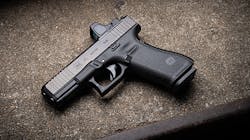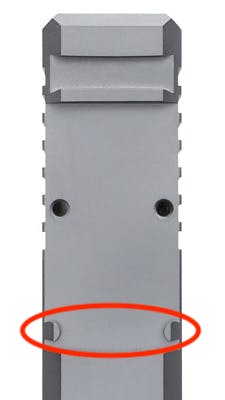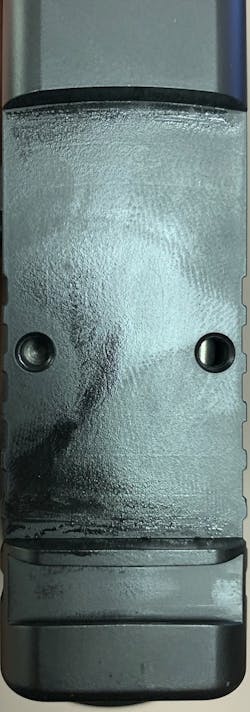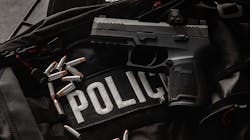As we age, our eyes lose the ability to focus at close distances, and that means it becomes harder for older personnel in law enforcement to focus on the front sight of a handgun. Sight manufacturers have addressed this issue by creating rear sights with a wider (.140” to .156″) notch to allow the shooter to see “light bars” around the front sight, tritium sights with contrasting colors, a rear sight with a vertical line which lines up with a circle on the front sight, and so on.
On the other side of the age spectrum, new recruits are coming into the field who may never have handled a firearm in real life, but who grew up on video games that featured red dot or reflex sights (RDS).
RDS attaches to a firearm, provides a 1:1 sight picture, and projects a virtual red dot onto the target without needing to place your eye close to and directly in line with the sight. I use the word virtual because, unlike a laser sight, only the shooter can see the dot on the target. No one else can see it, especially the suspect being targeted.
In 1975, the Swedish optics company Aimpoint AB marketed the first “electronic” RDS and in 2000, the U.S. military introduced an RDS into field use, the Aimpoint CompM2, designated the “M68 Close Combat Optic.”
“Train-up is easier for younger shooters. For shooters over 35 years old, RDS really helps to resurrect their shooting careers.”
— Scott Reidy, SIG Sauer Academy
Noting the advantages of RDS on rifles, competition gunners started using miniaturized RDS around the 1990s. These competitors found some major benefits using red dots, such as most-of-the-time viewability of the sight, target focus versus front sight focus, and binocular versus monocular vision. When it comes to law enforcement, RDS integration is growing. While RDS seems like the perfect answer for both young and old officers in law enforcement, like any bit of magic, you need to peek behind the curtain to get the rest of the story and before determining whether or not your agency should allow officers to mount RDS onto their sidearms.
How does it work?
In its simplest form, a RDS uses a lens or mirror to project the reticle onto a half-silvered mirror which lets you see the target with the reticle appearing on top of the target. Many different reticles are available from dots and circles in multiple sizes, to reticles with tick marks which can be used to gauge sighting at distance. Large dots are easier to see in bright light and close range, while smaller dots are better for low light and longer distance targets. I’ve consistently hit metal plates at 60 yards in windy conditions from a handgun with a 3” barrel using a RDS. Try that with iron sights!
The first RDS were red because they relied on the light emitting diodes (LED) that were available at the time. Just like firearm lasers, modern RDS are available in red or green and the color you choose depends on the mission. Green dots might get lost in the forest while red dots might get lost in a sea of tail lights and light bars.
“RDS are going to happen on pistols faster than they did on rifles. A substantial number of very large agencies on the U.S. West Coast are working on training programs.”
— Tom Jankiewicz, SIG Sauer
Besides LEDs, which require a power supply, RDS can be illuminated using fiber optics and tritium. Some sights use one or more of these methods. Again, which illumination method(s) to choose will depend on your mission, and all officers might not need the same type of sight.
In the early days of using RDS on pistols, they could not withstand the g-forces involved in the slide’s recoil, and the weight of the sight would affect the cycling of the firearm, causing failures. Competitors found ways of building frames which would hold the RDS just above the slide but mount somewhere on the pistol’s frame, such as the grip or rail.
As RDS manufacturers started making more robust sights, firearms manufacturers, such as FN, GLOCK, SIG, and Smith and Wesson started to make “optics-ready” platforms with cuts in the slides ready to mount your favorite RDS. As of this writing, a pistol mounting standard doesn’t yet exist, but many pistol and sight manufacturers sell adaptor plates which allow mounting almost any sight onto any pistol. For example, GLOCK sells four different plates.
Are RDS just a fad?
What if you don’t have an optics-ready pistol and you want to mount an optic on it rather than springing for a new pistol? While GLOCK GmbH may exchange your existing slide for a MOS (Modular Optic System) slide in Europe, they do not sell them in the U.S. However, several companies do make aftermarket slide kits for GLOCK. Just add all the internal parts, mount an optic up top and head for the range. Because of the modular nature of the SIG P-226 and P-320, you can buy a Caliber X-Change Kit already mounted with their Romeo1 RDS.
What if you need an optics-ready slide for a sidearm that doesn’t have one available from the manufacturer, or you don’t want to buy a whole new slide?
Deputy Sergeant and Rangemaster Robert Pronske of the San Mateo County Sheriff’s Office (Calif.) and Christopher Galli, the officer responsible for firearms training with the Santa Cruz Police Department (Calif.) note that many officers in their departments found machine shops that would make the cuts required to mount a RDS on their personally-owned duty weapon. Unfortunately, in one example, an officer went to a machine shop and came back with a hunk of metal that was once a GLOCK slide. Let me explain.
As you can imagine, the g forces acting on a pistol slide are tremendous. Upon firing, the slide unlocks from the barrel, slams back compressing the spring, picks up a new round, and slams forward putting the pistol back into battery. If you have a RDS mounted on top of the slide, it is subject to the same g forces. While current RDS are designed for those g forces, you need to ensure that whatever is securing the RDS onto the slide can take them, too.
Now, look at Figure 4. You can see that there are no recoil bosses, one hole is deeper than the other and the holes are improperly threaded. What you can’t see is that when mounted, the RDS has approximately 1/16th of an inch movement in the pocket side to side. Any one of these errors could get an officer killed in a gunfight. This is not to say that you cannot have your slides milled, it just says that you need to work with a reputable machine shop who has done this type of work before.
Technology is not fail proof
Like any mechanical object, RDS can fail. That means you need a backup plan. In the case of RDS, that backup plan means iron sights. But since an RDS is tall enough to hide normal sights, suppressor-height sights are required. While the optics-ready GLOCK comes with standard-height sights, aftermarket suppressor-height sights are available. The FN 509 MRD and SIG P320 RX come with pre-mounted suppressor-height night sights.
With adjustment tools for both the RDS and the iron sights and some quality range time, you should be able to co-witness your primary and backup sights. Horizontal co-witness is mandatory, but vertical co-witness depends on the shooter’s preference That is, the dot should always be centered above the sight picture when the sights are lined up in your line of vision—regardless of whether the iron sights are in the lowest part of the glass or dead center.
There is one failure mode that needs impeccable training—when exiting from an air-conditioned car or building into a humid environment, it is possible that the RDS could fog up. If this happens, both the RDS and the iron sights might disappear. Scott Reidy, director of training at SIG Sauer Academy, says, “To help combat the fogging we apply Rain X or Cat Crap. Additionally, we teach an occluded optics drill that still allows the shooter to see the red dot. And even with a fogged-up sight, the shooter still can place the dot on target if they keep both eyes open.”
“Properly trained…it is a faster sight picture, easier for long range engagements and is more effective in low light than traditional night sights.”
— Officer Christopher Galli, Santa Cruz Police Department (Calif.)
You may not want to install backup iron sights for older personnel until they go through most of their training. Both Pronske and Galli made it very clear that experienced officers spent a lot of time looking through the RDS for their iron sights – enough time to get them killed. Pronske also told me that because of muscle memory, older officers may have trouble trying to find the dot because they treat the RDS as if it was an iron sight needing perfect alignment. They need to remember that an RDS shows up on the target and not at the front of the weapon, like a front sight does.
Eliminating the iron sights from the equation can help experienced officers focus on the dot. Once they’ve built up speed and accuracy, the iron sights can be mounted for final training and qualification.
On the other hand, Pronske said that, “new shooters who grew up on videogames tend to lock up if the dot is washed out or the optic has failed. In both cases, substantial training is required to ensure speed and accuracy with an RDS.”
Reidy says that, “the biggest difference between new and experienced shooters is that train-up is easier for younger shooters—millennials and Gen Z’s pick it right up. For shooters over 35 years old, RDS really helps to resurrect their shooting careers.”
He agrees that training is mandatory and recommends a minimum of two full days of training before letting officers loose with a RDS. His train-the-trainer agenda can be found at sigsaueracademy.com. It includes a substantial number of drills pertaining to variable lighting, down optics, barriers and holdover/offset due to the optic. Reidy told me that with training, Los Angeles County deputies are hitting targets out to 200 yards.
Galli agrees that RDS are an extremely powerful tool—with the proper training. He explains,
“The officer simply focuses on the threat and places the dot over the desired point of impact. This is different from iron sights where the shooter must perceive and recognize a threat, align the front sight within the rear sight (the sight alignment), focus back to the threat and then shift their focus back to the front sight. Once the shooter places their iron sights over the desired point of impact (using the proper sight picture) shooters are told to focus on the front sight and that the rear sight and target should be blurry.
Most shooters using iron sights also close one eye, reducing their vision by 50 percent. Simply stated, using iron sights requires the shooter to think through three focal planes: the threat, the front sight, and the rear sight. Using an RDS reduces that to one: the threat.
Keeping both eyes open and focused on the threat allows the shooter to have greater situational awareness and potentially reduce bad shoots. Once the shooter is properly trained on an RDS, it is a faster sight picture, easier for long range engagements and is more effective in low light than traditional night sights.”
Create a policy
RDS might creep into your agency when officers decide they want to run them. While you could put your foot down, think about allowing select officers use them to gain knowledge of how they will work for you.
SIG’s Jankiewicz says that the largest agency allowing officers to purchase their own RDS for duty guns is the Houston Police Department. They have settled on four approved RDS including the SIG ROMEO1. SIG has made a standalone P-320 slide available to law enforcement only.
California’s San Mateo County Sheriff’s Office and Santa Cruz Police Department both have similar policies in place. The biggest concern for Sgt. Pronske is that officers buy quality optics and have their slides milled by an approved machine shop.
RDS are powerful tools and can add to officer and community safety. They are not “deploy and forget” but need a substantial investment in selection and training. Trainees can come up to speed faster and older shooters can regain their shooting prowess. Agencies should get ahead of the curve and develop policies before officers start using an RDS on their own.
About the Author
Ron LaPedis
Ron LaPedis has been a business continuity and security professional for over 25 years and frequently writes and speaks on business continuity, cybersecurity, physical security and public safety topics. He is a life member of the NRA, NRA-certified Range Safety Officer (RSO), NRA and California DOJ Certified Instructor, member of the International Law Enforcement Educators and Trainers Association (ILEETA), and serves on the boards of public safety, military and law-enforcement related organizations. Ron is a Master Business Continuity Professional (MBCP), an Associate Fellow of the Business Continuity Institute (AFBCI), a Distinguished Fellow of the Ponemon Institute and a Certified Information Systems Security Professional (CISSP).





